Travels with Grace: Vienna
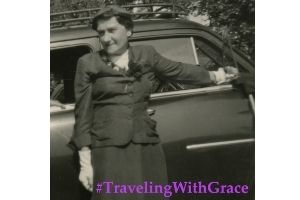
Welcome to this week’s segment of our 2019 #TravelTuesday series: Traveling with Grace. Today Grace heads to Austria during the summer of 1929.
August 4, 1929
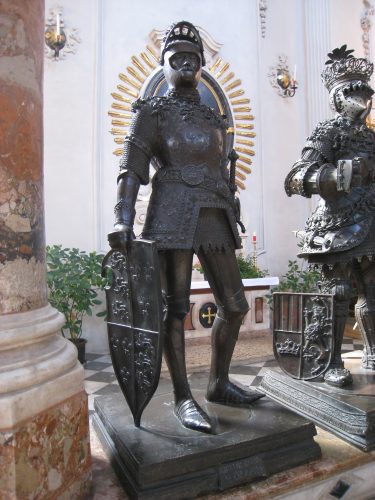
Sunday. We leave Bolzano by the 8:40 a.m. train and after a very pretty ride reach Innsbruck at 1 p.m. They remember us at the Tyrolerhof where we stopped two years ago. This afternoon we take a carriage and ride around this very quaint and attractive town, one of the cleanest I have visited. The weather is perfect, and everybody seems to be taking advantage of it. We see many of the picturesque ancestral costumes of the district, the women particularly looking like they have just stepped out of an antique painting. We first visit the Hof Kirche where we see some thirty larger than life size statues of the kings and queens of different lands, including King Arthur of England, done in bronze with remarkable care as to detail – for instance the armor on the men and the jewelry and brocaded dresses on the women. There is also a magnificent tomb – Kaiser Maximilian’s – in the center of the church adorned with 24 panels of carved alabaster in magnificent bas-reliefs. On the altar are ornaments of silver and gold.
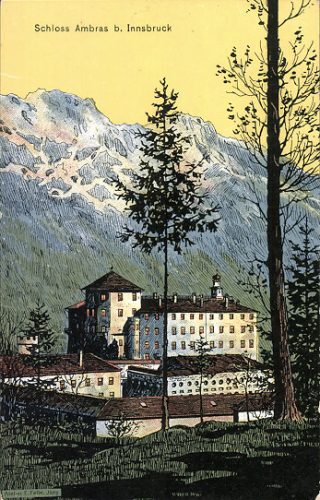
From here we ride to Schloss Ambras for a look at its fine park, the castle being closed. We pass a pretty little war cemetery on the way where Italians and Austrians are buried. In the old town are houses two or three stories high but so small that they look like children’s playhouses. In another part of the town are old beer houses and cafes uniquely decorated, one old hotel having a sort of register in marble before its door on which are inscribed the names of all the famous guests sheltered here in years past. One house bears a plaque commemorating the sojourns of Goethe and the Mozarts, father and son. There is a charming park where concerts are given daily. Many people are going up and down the funiculars which run to the top of several peaks of the Nordkette.
August 5, 1929
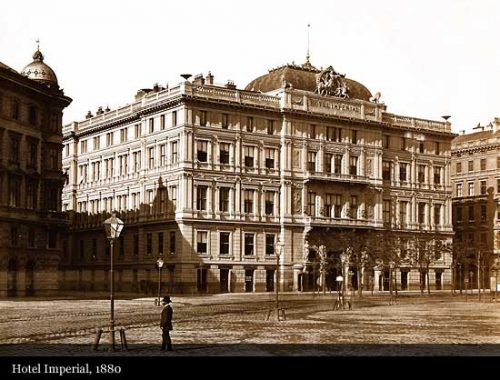
Monday. Left Innsbruck at 8:30 a.m. and came to Vienna via Salzburg and Linz. Part of the trip was very pretty going up through the mountains. In the afternoon the scenery becomes flat and then darkness overtook us. Arrive at the Imperial Hotel, Vienna at 10 p.m.
August 6, 1929
Tuesday. We take an automobile with guide this morning and ride around this beautiful city. It is quite flat, the streets very wide and clean (it is a fine of 4 shillings if one throws anything in the street) and the public buildings are very handsome. As most of the avenues are in a straight line, fine long vistas are afforded. One characteristic that I notice is the presence of little white mattresses in all the windows. People lean out on them and they keep the dirt out of the windows. Many places have a bunch of pine sprigs hanging before the door to signify that home-grown wine is sold there. The Ringstrasse is one of the finest thoroughfares I have seen anywhere. We ride through the Prater, a very extensive natural park, once a royal domain, given to the public by Joseph II, son of Maria Theresa. There are fine woodlands, lakes, racetracks, etc. We see the opera, very beautiful, a number of fine churches, one of the prettiest being the Votive Church, Parliament buildings, Universities, museums, a number of smaller parks, the barracks which are unusually attractive architecturally for this sort of purpose, monuments to Goethe, Haydn, Beethoven, Mozart, Schiller, Gegethoff, Schwartzenberg, etc. Ride along Maria-hilferstrasse, one of the principal shopping streets.
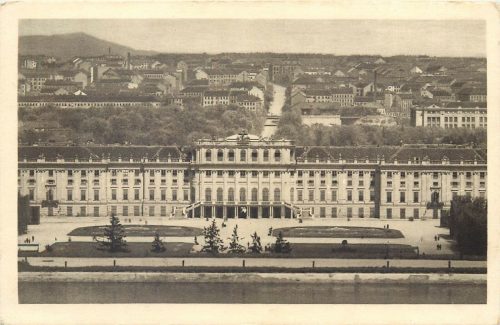
This afternoon we got to Schonbrunn castle where the grounds are very beautiful. There are close-clipped box hedges as high as two-story houses with statues fitted into the niches, a large Neptune fountain and the Glorietta on the summit of a grassy knoll where Maria Theresa used to take her tea and look down over the city. Then we ride out to Cobenzl, formerly a private palace, now a popular restaurant with terraced gardens and on the way, we enjoy a lovely panorama of the city with a glimpse of the Danube included. On our return to Vienna we stop at Demel’s for some lovely pastry. Then we see the Imperial Court, old and new palace with statues and fountains and the Heroes field and monument of Maria Theresa. We go to Schoner’s for an excellent dinner and later Rochenbauer’s where we had good wine and good entertainment, music, singing, yodeling, etc. and met Dr. Melvin Rosenthal.
August 7, 1929

Started out at 9:30 a.m. with private auto on trip to Semmering. It is a beautiful day and the scenery gains in loveliness thereby. We go through the following towns and villages: Weiner Neustadt, Neunkirchen, Glogguits, Klamm-Schottwien, Semmering where there are some nice villas and hotels situated on the heights commanding good views of the Raxberg and other mountains. At Kaiserbrunn we have lunch at a typical country restaurant where the tables are laid out in a cool grove and the dogs and chickens get mixed up with our feet. The food however is clean and palatable. Then on through Guttenbrunn, Perietz, Berndorf, Voslau, Baden where they have a floral clock in the Kurgarten, Gumpoldskirchem, Modling where we see a fine old tower souvenir of the Turkish invasion, Petersdorf, Liechtenstein castle a perfect example of 12th century architecture, and on back to Vienna. The trip affords a great variety of scenery through low-lying open fields, forests where buckets are strapped to trees for turpentine, green foothills and rocky mountains of quite respectable height graduating upward. Many of the mountain streams are well stocked with game fish. Up in the Semmering where it is delightfully cool in comparison to the city, we see the reservation fenced off where are the wells and springs, source of Vienna’s good water supply. Tonight, we have dinner at Stadt Park Restaurant where a band of music plays and all are gay and animated on the brightly lighted terrace overlooking the gardens.
August 8, 1929
This morning we spend in the Liechtenstein gallery, one of the finest private collections of art treasures in Europe. There are some interesting bronzes and porcelains in addition to the pictures and all displayed to excellent advantage. Then we visit beautiful St. Stephen’s cathedral and see the lovely monument by Canova to Maria Theresa in the Augustin church.
At 12 noon we go to the Hoher Market to see the Ankeruhr, an interesting piece of mechanism, 12 figures passing in slow review upholding the hours while an organ plays classic music. Each is a character important in the history or culture of the country beginning with Marcus Aurelius, Karl der Grosse, Herzog Leopold von Babenberg with his consort Theodora, Walter von der Vogelweide, Rudolf von Hapsburg 1st of that line, the mater architect Puchsbaum builder of St. Stephens, Kaiser Maximilian, Burgmeister Johann Liebenberg, Graf Rudiger von Starhemberg, Prince Eugene of Savoy, Empress Maria Theresa with her consort Franz von Lothringen and las the musician Josef Haydn. With each comes a different descriptive tune. Tonight, we hear the operette “Rosenaus Florida.” Most everyone seems to have lunch with them.
August 9, 1929
We spend several hours in the glorious Art-History museum, one of the richest in old masters I have yet seen. It has also a large collection of tapestries, jewels, ivories, and other objets d’art. We have lunch at a typical old Viennese restaurant with low vaulted ceilings near the statue of Lieber Augustin, noted for its good Pilsner. This afternoon we see the wonderful old coaches at Schonbrunn, including the monumental coronation equipage with panels painted by Rubens and all heavily encrusted with gold leaf. Also, sedan chairs and sleigh used by Maria Theresa. The latter she insisted upon using even in summer when she had salt poured on the roads so it would slide. Also, the tiny pony drawn carriages that were l’Aiglon’s. Next we visit zoological gardens where the bird collection is most interesting.
Thanks for reading “Traveling with Grace,” a series where we’re sharing (and annotating) posts from the travel diaries of Grace Amelia Hecht, native Baltimorean, b. 1897 and d. 1955. As mentioned in my introductory post transcription errors sometimes occur and I’ve made my best guesses where possible, denoted by [brackets]. – Rachel Kassman, marketing manager
